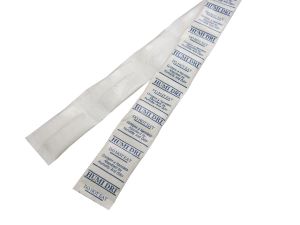Humi Dri continuous strip desiccant offers protection against high humidity levels. These desiccants are tailored to automated production lines and are available in roll and spool forms.
Effective Moisture Control
Manufactured in-house at Stream Peak, our adherence to ISO 14001 and ISO 9001 standards ensures the production of high-quality products while upholding stringent environmental and quality management practices.
Our spools are available with desiccants such as activated carbon, activated alumina, molecular sieve, and silica gel. Using these with a humidity indicator card and moisture barrier bag ensures optimal moisture control.
The strip desiccants can be used in large-scale production environments. Their automated feeding mechanism eliminates manual insertion, enabling seamless dispensing into packaging. This automation significantly enhances the packaging line’s speed, increasing productivity and efficiency.
Comprehensive Testing for Absorption
Available in a variety of materials such as paper, hard paper, kraft paper, heatlon, Tyvek, plastic, sewn bags, or tear-proof (TP) fabric, the spools are rigorously tested in our quality assurance lab to ensure optimal absorption rate, capacity, and durability under various conditions.
They can safeguard moisture-sensitive products such as garments, shoes, consumer electronics, packaging machinery, equipment, and devices. We offer customisation to meet various application needs, including bulk orders or specific printing requirements.
- High-quality strip desiccants for managing moisture and gas levels
- Easy-to-use spool form (Humi Dri Spool)
- Diverse packaging material options
- Customizable with various desiccant types
- Effective moisture absorption over an extended period
- Easily replaceable when saturated
- Integration into automated packaging lines
- Adherence to ISO 14001 and ISO 9001 standards
- In-house testing for performance assurance
- Range includes activated clay, molecular sieve, and silica gel
- Optional humidity indicator cards for monitoring
- Customization for branding and labelling
- Size: Available in various sizes ranging from small sachets to large packets
- Packaging options: Pouches, packets, canisters, or bulk bags
- Moisture absorption rate: Typically between 20-30% of the desiccant’s weight
- Shelf life: Generally between 1-2 years, depending on the product and storage conditions
- Working temperature: Typically between -40°C to 60°C
- Humidity levels: Effective in humidity levels up to 90% RH (relative humidity)
- Toxicity: Non-toxic and safe for use with food, electronics, pharmaceuticals, and more
- Environmental impact: Recyclable and safe for the environment
- Certifications: Meet standards such as FDA, REACH, RoHS, and ISO 9001
- Applications: Ideal for use in the storage and transportation of products in various industries such as food, electronics, pharmaceuticals, textiles, and more
- Features: Easy to use, durable, and long-lasting, helps maintain product quality and integrity


